What is this guide?
A simple introduction to the inbound marketing methodology with the needs of corporate franchisors and franchise owners in mind.

A simple introduction to the inbound marketing methodology with the needs of corporate franchisors and franchise owners in mind.
Franchise marketers at the corporate level looking to help existing franchise locations grow. Check out our franchise marketing library if you’re trying to attract more franchise buyers.
In this guide, you’ll learn:
Not generating as many leads as you’d like for your franchise business?
This guide shows you how to reverse this trend through targeted, cohesive digital marketing tuned specifically for franchises looking to grow.
To do so, we’ll pull from best practices and our winning lead generation strategy that helped locations of a national franchise increase marketing-generated revenue by 220.29%.
Before you refine your franchise lead generation strategy, make sure you have these basics covered:
Let’s walk through each of these:
For a franchise business, branding is critical. Customers often choose to do business with a franchise location because they’re seeking a consistent experience.
If you don’t have a corporate brand guide that dictates how your brand speaks, what it cares about, and how it expresses itself through color, typography, copy, and other brand elements, you risk sending mixed messages to customers.
What’s more, if you do have a corporate brand guide and some of your franchisees aren’t following it, you run the risk of diluting your brand.
Here are some general tips for developing a brand identity relevant to a franchisor. Use these to evaluate your current brand and spot strengths and gaps. If you need to improve in any of these areas, start there first.
Reflect on who exactly you’re speaking to in marketing communications. Odds are, you’ve been in this business for a while, and have a pretty good idea of what a good customer looks like.
If you haven’t already, document this knowledge so it can be refined and made accessible to other members of your team who might be less seasoned.
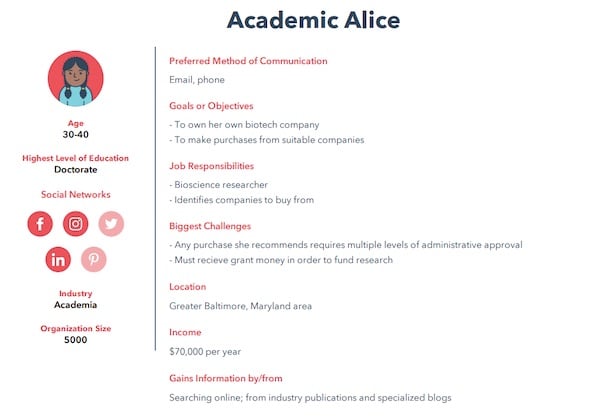
These profiles are sometimes called “buyer personas.” They include key details about what you’re looking for in a customer, like common sales objections, goals, and concerns. Many companies have more than one. Franchises have at least two: an ideal end customer and an ideal franchise buyer.
Buyer personas are useful because they help your marketing, sales, and customer service teams understand who they’re talking to and what makes those people tick.
The result? Ideally, better messaging, better sales conversations, and better customer service.
We’re all familiar with the sales funnel as a model of leads moving through your sales cycle. The buyer’s journey model documents essentially the same process, but from the buyer’s perspective.
Instead of focusing on the buyer gaining familiarity with your company and getting closer to buying, this newer model is solution-focused.

The buyer becomes aware of a problem that drives them to find a solution that you sell, and chooses you as the vendor.
The buyer’s journey has 3 stages that roughly map to the traditional funnel’s.
Along the way, the buyer has different levels of understanding of their situation, potential solutions (including yours), and potential vendors.
The buyer’s level and depth of awareness dictates the most helpful (for them) and advantageous (for you) way to engage them.
For example, a foundation repair franchise wouldn’t want to expound on the virtues of piers and carbon straps to a prospective buyer who doesn’t know the crack in their basement wall is more than a water damage hazard.
Mapping out the sorts of specific questions, concerns, and research habits your clients have at each of these stages, as well as an average timeline for the entire sales cycle, helps you create more relevant, engaging content for franchise lead generation.
More importantly, this information can be used strategically to maximize your marketing efforts by focusing on strategies that target the more qualified decision stage individuals first, convincing them you’re the right vendor to solve their problems.
From there, you can pursue prospective consideration and awareness stage customers according to their needs and behaviors.
Let’s dig into the types of marketing activities you might want to engage in at each stage.
At this stage, buyers are ready to talk to sales and are focused on choosing the best vendor for them.
Consider:
Do you have a sales enablement process in place to ensure franchise web leads get sent to the right locations?
For example, do you prioritize especially promising leads such as those that come from an industry you like to serve or have a job title that tends to have more decision-making power?
Do you have the platforms and conversion tracking in place to ensure conversions get tracked back to the leads' first marketing touch?
While difficult to execute, it’s worth the effort because it gives you critical information about what tactics are working that makes every marketing decision you make so much easier.
Is there a clear path to conversion on your website for users who are ready to talk to sales?
To generate franchise leads, you have to make it easy for low-funnel leads to get in touch with you directly. This could be an embedded form or link to your contact page, or even a button inviting them to call for a quote at the top of your homepage and service pages.
Do you have content that addresses key decision-stage buyer questions, such as pricing?
If your customers have a tendency to spend a lot of time researching their options before a purchase, such as learning about solutions and vendors, high funnel blog content and company updates will not satisfy their needs.
Instead, you need to determine what information they need to decide whether you’re the right vendor for them, such as pricing pages or how you measure against competitors.
Does your website have a lot of social proof to help convince decision-stage buyers that they're making the right decision?
Social proof, or feedback from your community and industry that validates your business, can make all the difference when it comes to landing pages or even conversion-focused web pages like those describing your services.
For example, reviews are critical for local businesses (including franchise locations). According to one survey, 98% of consumers leave and read local business reviews. The survey goes on to say that “A high star rating would make 58% of people feel positive about choosing a local business.”
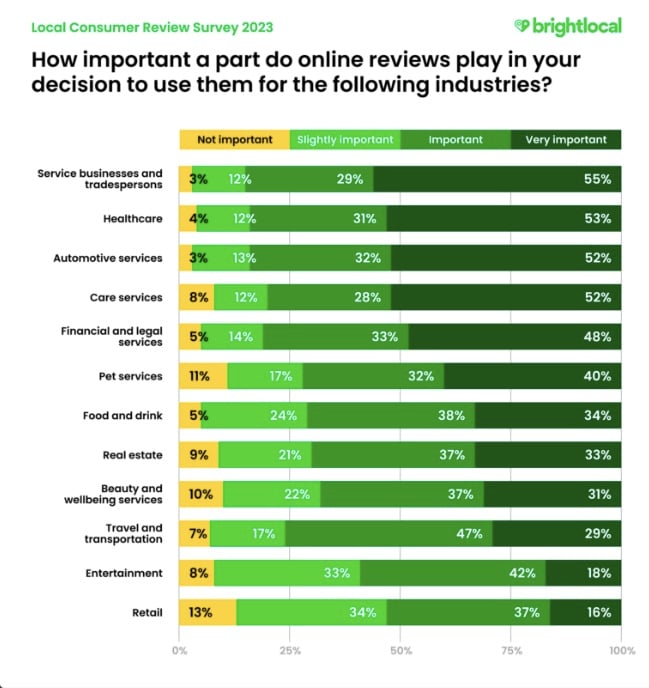
At this stage, buyers already understand their problems and are actively searching for solutions, often online. This means that SEO and PPC are very important at this juncture.
Consider:
For inbound leads generated via your website and ads, do you have a basic sales enablement process in place to make sure the right franchise leads get to the right salespeople/owners?
For example, do you have a system like the following?
Is your website set-up with a clear path to conversion and clear next action on every conversion-focused page?
On pages designed to sell, like service pages, do you tell visitors what they can do next to move forward? For example, on a SAS product page, a logical next action for a visitor might be to ask a visitor to fill out a demo form.
Are your lower-funnel landing pages optimized for conversion of in-market buyers?
For example, do your landing pages have the following?
Do you have website content that compares your solutions to those offered by competitors?
For example, do you offer a brand comparison guide or page?
Are your PPC landing pages optimized for conversion?
For example, does your form only ask a few questions, or is fairly long? It’s conventional wisdom that shorter forms are better for conversion.
Is your website (or the individual location websites, if they're not all part of the corp site) search engine-optimized—Particularly in the context of local SEO? (See "on-page signals".)
For example, do you have content referencing the location(s) you serve and discussing?
Are you optimizing your Google Business Profile?
This is arguably the second most important local SEO resource after your website. Searchers may see it before they reach your website when searching for your brand and use it to size up your business against others like it in Google Maps.
This is part of the reason why it’s essential that it be claimed, up-to-date, and complete.
Do you have a review generation strategy that brings in a steady stream of reviews to each franchise location?
Reviews not only provide searchers assurance that your business is reputable, but steadily getting new ones can help your SEO.
Is your citation profile in good shape?
Citations are mentions of your business information online, so your citation profile refers to all these mentions across the web, and the picture they paint for potential customers.
Having complete, up-to-date information helps searchers find accurate business information and can help you make a favorable first impression if prospects find your citation before visiting your site or brick and mortar business.
Are you picking low-hanging fruit when it comes to link-building?
Links have been, and still are, essential to your online visibility. Both links from one page of your site to another and sites from outside sites to yours are important.
The practice of link building refers to the latter: external links. In general, the more you get from reputable sites in your industry, the better. Getting them is easier said than done.
Fortunately, there are a few easy asks every business should make. For example, asking sites that already mention your brand to link back to your site, and building your citation profile (see previous point).
What unbranded keywords are used by buyers who already understand they have a problem and are actively looking for solutions you provide?
Unbranded keywords are simply search terms that do not directly mention your brand. These keywords will likely represent the bulk (or entirety) of both your PPC targets and local microsite/website optimization targets.
Here’s an example: “24-hour emergency vet.” This person knows they need a veterinarian, and they are ready to buy now.
At the awareness stage, buyers don’t understand what their problem is, only the symptoms they are experiencing. That’s why this stage is where educational blog and pillar content created at the corporate level can be really helpful.
Consider:
Does your blog content lay out a clear next action for buyers to take once they understand their problems and are ready to start thinking about solutions?
If you want your content to nurture and convert franchise leads, you need to include a relevant, appropriate next action for the reader to take.
For example, a post that lists common symptoms of foundation issues might have a next action like “get a free quote for foundation repair. We’ll explain your options and help you find the best solution.”
Is the blog content you create thorough, authoritative, and optimized for search visibility?
A great blog post is easy to find in search engines, well-researched, ideally written by someone with firsthand experience, and answers all the searcher’s questions without overwhelming them with fluff.
This is the kind of content that helps potential customers move forward in their buying process and earns you credibility.
What keywords are used by people who are exhibiting and researching problems that you can solve? What's the best way to rank for those keywords?
While many of these keywords are too broad to make good PPC targets, some are worth targeting. For example, keywords like “cracked wall repair,” “dirty tile solution”, or “clogged pipe causes”.
All businesses need fast, user-friendly websites that attract the audiences they care about by delivering them the information and services they seek. A modern, easy-to-use franchise website—one that’s optimized to appear in relevant search results—is the foundation for lead generation. It’s the place traffic turns into leads.
Here are some points that explain why the website is (and will probably always be) so essential:
Plus, a well-executed franchise website optimized for lead generation serves as a 24x7 salesperson, providing franchise leads with the resources to answer their questions, qualify themselves, and even convert by filling out a contact form—all before talking to sales. This means less busy work for your sales and customer service teams.
According to Whitespark’s survey of local search engine marketing experts, here are 10 boxes your website should check to get found easily by potential customers.
Learn more about what goes into a great franchise website with our free guide: What Makes a Great Franchise Website in 2023?→
A landing page is a web page built with the goal of capturing a visitor’s contact information through a lead-capture form.
They’re often used to convert in-market prospects via lower-funnel, sales-oriented offers—such as demos, estimates, and consultations. This is especially true for individual franchise locations, where the sales process tends to be more transactive.
They’re where leads actually convert (or don’t).
That’s why they should be a serious consideration when you’re choosing a content management system, refreshing your site, or starting a new marketing campaign.
If you’re engaging in any kind of digital lead generation, odds are your entire franchise lead strategy hinges on the quality of your landing pages. Here’s why.
If you’re sending paid search traffic to your homepage or other places that aren’t optimized for lead generation, this is without a doubt the one thing you need to do to drastically improve your lead numbers. All it takes is a little planning, content creation, and implementation.
Not doing so is no different than closing your eyes to those looking for a business opportunity like yours.
Landing pages are the easiest way to generate franchise leads you can segment, nurture, and send on to the sales team when the time is right.
Franchise marketing offers and landing pages are connected at the hip.
Without landing pages, you’re stuck letting your offers go out to potential buyers without any exchange of valuable contact information—the core component of what makes inbound marketing work.
Landing pages aren’t only about generating brand new leads; they’re also a crucial tool in understanding which of your existing franchise leads are actively engaging more than others.
Based on the kinds of content and offers they’re downloading, your sales team can score leads accordingly and engage with the kind of message they want to hear.
Think of each landing page as another data point your marketing team can use to optimize your inbound franchise marketing strategy.
By tracking and analyzing the metrics your landing pages are gathering such as how many people are downloading a certain offer or resource, you can start adjusting new content to focus on the subjects and ideas that are most compelling to visitors.
Here are some common digital marketing tactics franchises can (and have) used to generate qualified franchise leads.
SEO is, essentially a three-step process:
SEO is a set of multidisciplinary best practices that serve a common goal of helping your business rank in search engine result pages for terms associated with problems your business can solve.
SEO tactics do this by attempting to satisfy specific factors that Google and other search engines use to rank pages. A few are known, others are speculation on the part of experts based on qualitative and quantitative evidence.
According to a recent survey of local search experts for example, the top 10 most important SEO factors for local websites are:
These are just a few of the standards that searchers and/or search engines may be using to judge your website.
It attracts qualified traffic to your site and other places your brand lives online, like your Google Business Profile, and helps keep them there with a good user experience.
From there, your website can sell them on your brand, leading them toward opportunities to convert into leads.
Each SEO provider commodifies their services a little differently, but here are some common SEO services franchisors can benefit from:
Or, you could get started with the DIY approach. Check out our free guide to learn more →
One way to generate (and nurture) franchise SEO leads is through content.
Content commonly lives on places like your social media profiles, your Google Business Profile, and your website.
Great content helps your target audience, whether that’s prospective franchise buyers or customers. It attracts qualified people to your site, where they can become leads.
For example, the page pictured above clearly outlines how a pet franchise’s product compares to similar fences on the market. This type of content can help a potential customer move closer to a purchasing decision.
This page is designed for a potential customer who is further along in their buying process: they’re already educated about their problem and potential solutions.
For franchises new to content marketing, we often recommend starting with content geared to buyers at this stage, because they’re almost ready to buy.
From there, you can create content that attracts potential customers earlier in their research process who aren’t ready to buy yet, but would still be a good fit for your solution.
First, ensure your site covers the basics about your franchise so prospects can easily find it. This includes:
When it comes to less basic topics, while you could make an educated guess, it’s safer not to assume anything and instead do a little research to identify what your current customers/franchisees already want to know.
Here are a few ways you can do this:
Sound like a lot of work? Outsourcing content creation to a third party is one way to lighten the load.
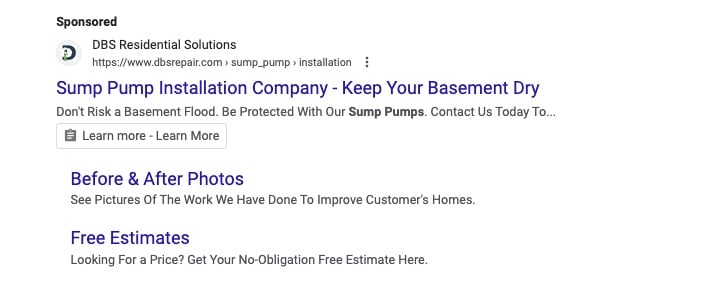
A paid search ad in Google
PPC stands for “pay per click.”, Pay per click is also sometimes referred to as known as “paid search advertising,” or “SEM” (search engine marketing).
With this model, you must pay every time someone clicks on one of your ads, hence “pay per click.”
Beforehand, you choose which types of searches you wish to appear for and select a strategy that maximizes your budget.
For example, a Madison roofing franchise might bid on the keyword “copper roof installation madison”.
Here’s what that process might look like in the wild:
PPC advertising can be a fast way to generate leads for your franchise locations. It’s relatively easy to set up, and once it’s turned on, it has the potential to start generating leads instantly.
But there’s an art and a science to doing this profitably.
Poorly managed PPC campaigns can drive up expenses without generating good ROI.
That’s why it’s smart to learn best practices and ease into PPC investments so you can determine whether this channel will pay off for your franchise.
Here are some best practices to help you get started.
Bid on high intent keywords

While you might think that more general keywords like “copper roofs” would scoop up a wider audience and therefore result in more clicks, this actually can work against you.
A wider audience clicking your ad would probably include people who aren’t in the market for your product or service and those who aren’t ready to buy yet. As a result, they don’t convert, and you waste ad spend.
Instead, go after keywords that signal the highest buying intent or qualification to buy like “copper roof installation madison” which are more likely to be searched by your target audience. In general, these keywords tend to be more specific as well.
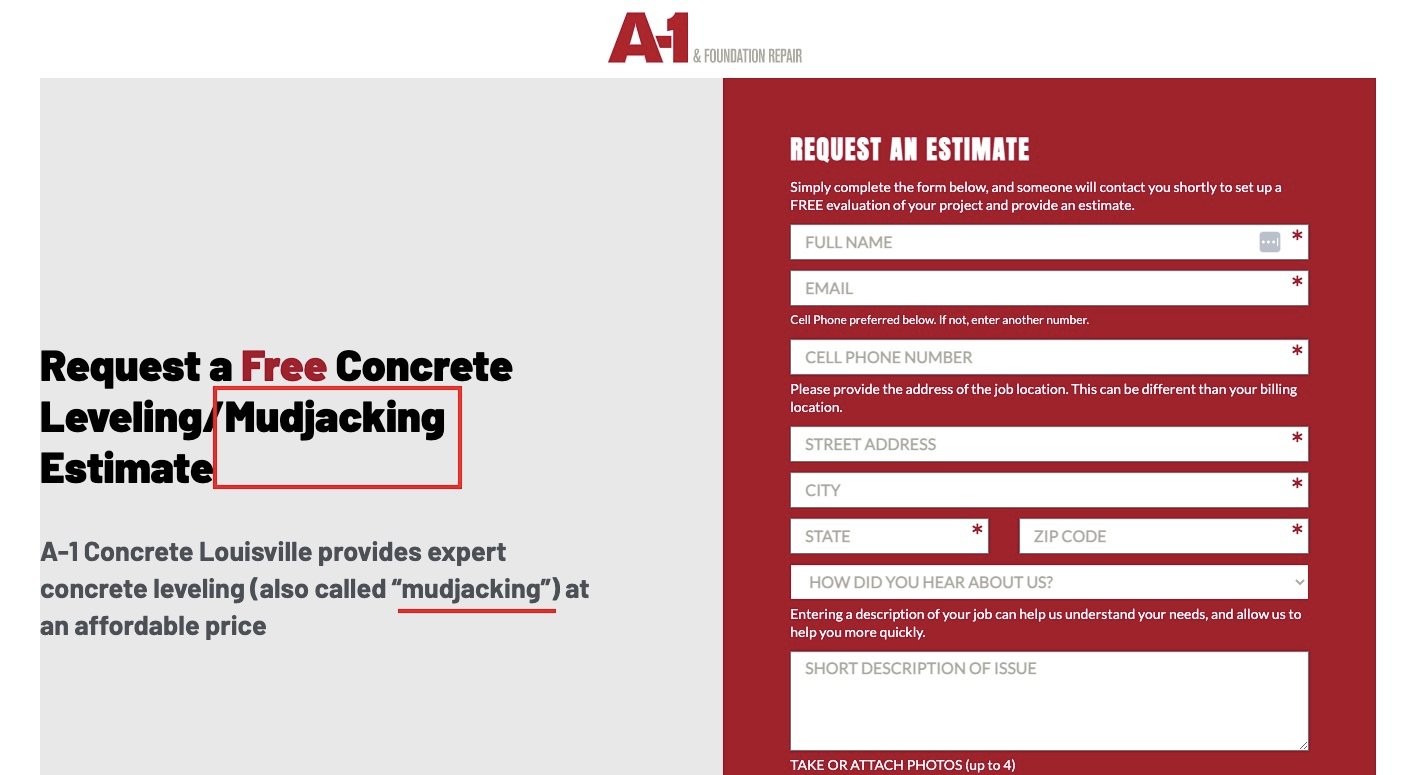
Source: A-1 Concrete Leveling Louisville
Create compelling franchise landing pages that align with the keywords you’re bidding on and the copy used in your ads
One of the biggest mistakes that many businesses make with pay per click ads is sending searchers to generic landing pages, like your homepage.
The most enticing ad in the world will likely have trouble getting a conversion if the landing page doesn’t meet the searcher’s expectations.
For example, if you’re selling copper roof installation, but you send visitors to your franchisee’s homepage, they’re going to have to make the extra effort of finding your copper roof installation service page.
If they land on your corporate website, that adds another layer of complexity, because they will also have to find the right location.
Even if they land on a dedicated landing page designed for your ad campaign, but it doesn’t describe this specific offer in detail, it might not be persuasive enough to fill out a form.
Instead, create variants of your ad landing page for each offer that provide extra details about the offer and reasons why they should give you a try, such as testimonials, awards, accreditations, or number of customers served.
Bid on branded keywords

You might think it’s pointless to pay to appear in searches that include the names of your brand, product, and services. After all, you’re probably appearing for these already in regular search results.
But, if you don’t pay to appear for branded terms, your competitors probably will.
This may sound like stealing, but it’s actually a very common strategy.
Think about it: You’re a potential customer that’s heard good things about a certain Madison roofing franchise.
You search for that roofing franchise by brand name, thinking you’ll check out their website to learn more, or maybe even get a quote for a copper roof installation.
At the top of search results, the first thing you see is an ad for another franchise. They have a special offer—get 20% off your first copper roof installation.
That sounds pretty good. Might as well check them out now, right?
The ad doesn’t have the first franchise’s copyrighted brand name anywhere in it, but when this competitor set up their campaign, they paid to appear for that term when it was searched.
This is how competitors eat your lunch.
You have no control over what keywords they bid on, but you can elbow your way in next to their ads by bidding on your own branded terms.
Let’s replay this scenario, but now our Madison roofing franchise is bidding on its own brand terms.
This time, when the searcher goes to learn more about them, their ad appears right next to their competitor’s.
Now the playing field is more level.
It may sound obvious, but keeping a close eye on the performance of your campaigns provides you with the data you need to decide whether to invest more or pull the plug.
It also helps you present key takeaways to your management team so you can get the budget you need to generate more revenue.
Terms people search for when they’re ready to make a purchase or visit a business are low-hanging fruit.
For example, our term “copper roof installation madison” is probably one of these.
Why?
“Copper roof” suggests a person who knows what they want already. “Installation madison” suggests a person who’s ready to have a copper roof installed and is looking for a local vendor.
Contrast this with “copper roof installation” without the addition of “madison”, which could be someone earlier in the buying process researching copper roof installations as an option.
Paying to appear for terms used by those ready to buy makes it easier to attract searchers who are ready to convert into franchise leads.
We often recommend our clients start small with PPC: start with a limited, targeted campaign and invest a modest amount of money.
This helps you gather baseline data about your search ad performance. For example, you can see which ads performed better than others and whether your results met your ROI goals for the campaign or fell short.
These results can help you gauge whether PPC is likely to be a worthwhile channel for you and iterate on what worked.
Social media sites are also great online platforms for paid ads.
Facebook and LinkedIn for example both offer powerful targeted advertising that places ads where they can be seen without being overly interruptive.
Here are a few pointers from Neil Patel, LinkedIn, and Hootsuite.
Craft the most compelling offer you can devise. As Patel points out, this may be even more important than the wording of the ad.
How do you do that? It has to speak to the needs, wants, and feelings of your target audience. Empathy is the key.
Consider:
Ad platforms like LinkedIn and Facebook offer countless ways to target specific groups of people based on factors such as location, time of day, demographics, industry, job title, and more.
Take advantage of these options to show your ad to the people most likely to become good customers.
A/B or “split testing” where you create two identical ads but change one aspect, is incredibly helpful for identifying what works and what doesn’t in an advertising campaign.
Experimentation, in general, creating multiple ad variants per ad group, is helpful. However, to really pinpoint what causes one ad to perform better than another, the more you limit the differences between them, the better.
Create multiple ad groups to cluster similar ads together based on a shared characteristic, such as a topic.
Experiment with different images, ad copy, and audience targeting settings to find the goldilocks zone.
While it may be tempting to measure ad performance in terms of clicks and views, remember that it’s actually the resulting sales that matters most. Make sure you have revenue attribution set up so that you can determine the ROI you’re getting from your ads.
If you find that you’re spending more than you’re getting back on ads, even if they seem to be getting a lot of engagement, pause the campaign and diagnose what’s going wrong so that you don’t continue losing money.
Hint: sometimes it’s your landing page.

The more leads your franchise’s sales team has to juggle, the harder it is to sift the wheat from the chaff and the more useful a lead scoring system will be for your franchise.
Lead scoring is the process of prioritizing leads based on their perceived value and likelihood of becoming customers.
This can be as simple as labeling contacts by their funnel stage (or lifecycle stage in HubSpot) and engaging the qualified franchise leads first.
Or, if you’ve found that particular traits or behaviors, such as visiting certain pages on your franchisee recruiting microsite, correlate with conversions, then you can earmark those leads as potentially more valuable.
Franchise lead scoring can be as simple or as complex as your needs. A more sophisticated but involved approach involves creating a numerical scoring system that assigns point values for multiple traits and behaviors like the one described above.
In any case, the sooner you find a system to prioritize leads that works for your franchise, the less of your sales team’s time you will waste, helping them focus on reaching out to the right people sooner and more often.
For those who are unfamiliar, lead nurturing is the process of nudging leads closer to making a purchasing decision by providing them with resources to help them learn about their problems (like earning steady income), potential solutions (becoming a franchisee), and potential vendors (like your franchise).
Instead of providing brochures and their webpage equivalents, which sell potential franchisees on why your franchise is the best, the focus is on how you can help them reach their goals through purchasing one of your franchise locations.
To do that, provide resources that help potential franchisees learn more about what your opportunity has to offer them and information about your industry.
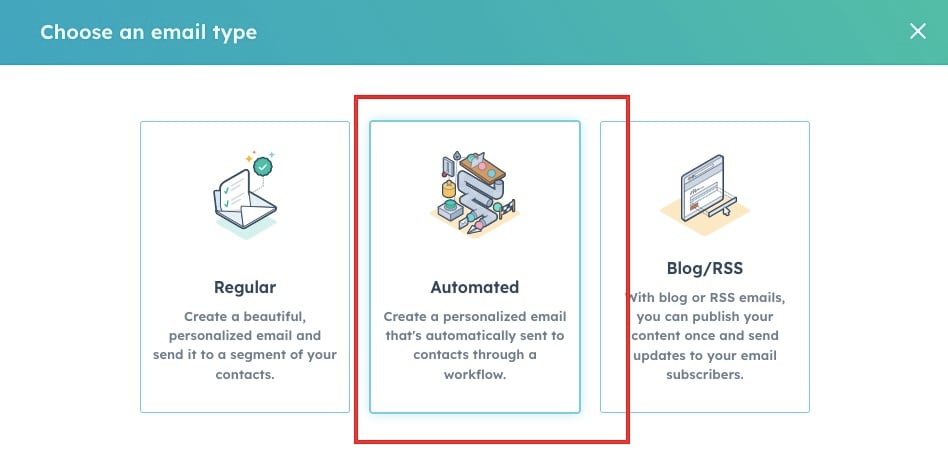
Gone are the days when salespeople had to send every email manually and individually.
Today, you can set up automation to respond to franchise queries automatically, follow up, reach out when an individual takes a certain action on your site, deliver resources, and even include personalized touches pulled from a subscriber’s contact record, such as their company name.
This is only one example of how digital marketing automation can take busywork off your sales team’s plate.
Reporting on campaign metrics is critical for demonstrating to the C-suite the effects of your franchise marketing efforts—and why you should get next year’s budget amount.
Here are three metrics you definitely want to keep track of.
This metric tracks what percentage of the money you spend acquiring a franchisee can be attributed to marketing. If it’s high, and increases over time, this is a sign you need to adjust your marketing strategy.
Here’s how to calculate it:
First, figure out how much you spend to get a new franchisee:
Franchise acquisition cost = (sales cost + marketing cost) ÷ number of new franchisees over a specific time period
Then, calculate how much of this is from marketing:
Marketing % of franchise acquisition cost = marketing cost ÷ (sales cost + marketing cost)
This metric tracks how many of your customers started out as marketing generated franchise leads. Obviously, this is a great number to show leaders when justifying marketing spend.
Here’s how to find it:
New buyers who started as marketing leads ÷ the total amount of new franchisees in a given span of time = the marketing-originated customer percent
This metric helps you quantify how your marketing efforts might have influenced customers who originated as leads outside of your marketing campaigns.
For example, if a future customer read one of your lead nurturing blog posts, that might have helped move them closer to becoming a customer.
Here’s how to calculate it:
Number of new franchisees in a given time ÷ the number of those who interacted with your marketing team.
We hope you found our playbook helpful! If this sounds like more work than your already loaded plate can hold, we’re here to help.
